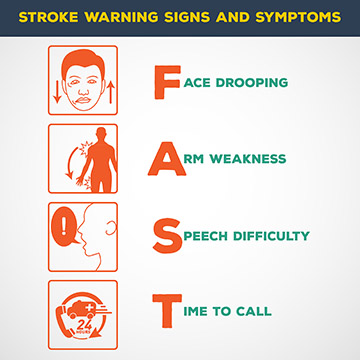Every year more than 600,000 Americans experience a stroke. Stroke is the fifth leading cause of death in the United States and a leading cause of serious, long-term disability in adults. Like heart attacks, brain attacks can be preventable, and quick treatment can reduce death and disability.
A stroke, sometimes called a brain attack, damages the brain just as a heart attack damages the heart. A stroke occurs when the flow of blood to the brain is stopped. Brain cells in the affected area don’t get the oxygen and nutrients they need so they start to die. When brain cells die there can be loss of function, and areas affected can include speech, sight, movement and/or memory. Some people who have had a small stroke experience only mild effects like weakness in an arm or leg; some recover completely. Large strokes can cause permanent disability and death.
A stroke can be caused by a blood clot that blocks a blood vessel or artery to the brain (ischemic stroke), or by a ruptured or burst blood vessel in the brain (hemorrhagic stroke). Strokes occurring from clogged vessels are more common and account for 87 percent of all strokes.
 Strokes are more treatable than ever, but time is critical. Think F.A.S.T. to recognize and respond to the signs of a stroke:
Strokes are more treatable than ever, but time is critical. Think F.A.S.T. to recognize and respond to the signs of a stroke:
- Face drooping — Does one side of the face droop or is it numb? Ask the person to smile. Is the person's smile uneven?
- Arm weakness — Is one arm weak or numb? Ask the person to raise both arms. Does one arm drift downward?
- Speech difficulty — Is speech slurred? Is the person unable to speak or hard to understand? Ask the person to repeat a simple sentence, like “The sky is blue.” Is the sentence repeated correctly?
- Time to call 911 — If someone shows any of these symptoms, even if the symptoms go away, call 911 and get the person to the hospital immediately. Check the time so you’ll know when the first symptoms appeared (this can make a difference in the kind of treatment given).
Beyond F.A.S.T., other symptoms you should know include:
- Sudden NUMBNESS or weakness of face, arm or leg, especially on one side of the body
- Sudden CONFUSION, trouble speaking or understanding speech
- Sudden TROUBLE SEEING in one or both eyes
- Sudden TROUBLE WALKING, dizziness, loss of balance or coordination
- Sudden SEVERE HEADACHE with no known cause
A key word is sudden. In our daily lives, most of us have occasional headaches, changes in vision, numbness and even weakness. So how do you know if these relatively common symptoms are signs of a medical emergency? The symptoms will come on suddenly and for no apparent reason. Experiencing only one symptom for even a short period of time can be a sign of stroke. Stroke symptoms will usually last for only several minutes; however, they can last for up to 24 hours.
Transient ischemic attacks (TIAs), sometimes called mini strokes or warning strokes, are sudden but temporary interruptions of the blood supply to the brain. TIA symptoms occur rapidly and last a relatively short time; however, this is a warning that should be taken very seriously. Many TIAs go undiagnosed. Talk with your health care provider even if you have had only one stroke warning sign that did not last a long time. Your health care provider may be able to help you prevent a major stroke.
This information is being provided for educational purposes. Your health care provider can make recommendations specific to your situation. Follow your health care provider’s advice.
Adapted by Gail Carlson, former University of Missouri Extension health specialist
References
American Heart Association, http://www.heart.org/
American Stroke Association, http://www.strokeassociation.org/
National Stroke Association, http://www.stroke.org/
National Institute of Neurological Disorders and Stroke, https://www.ninds.nih.gov/